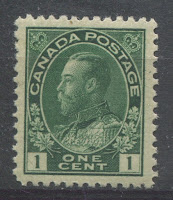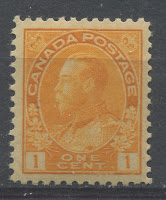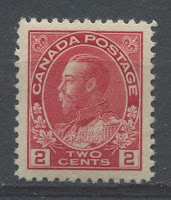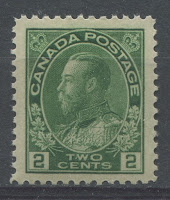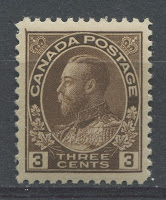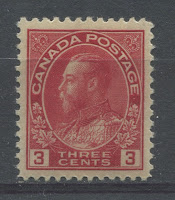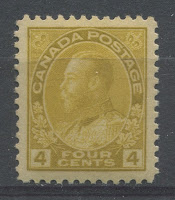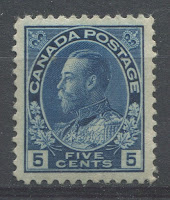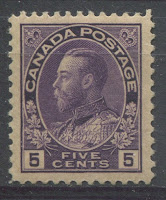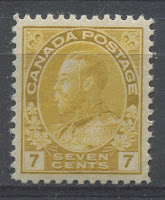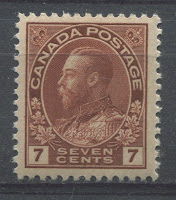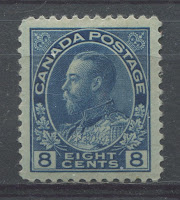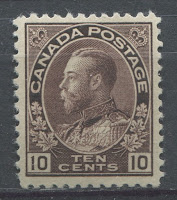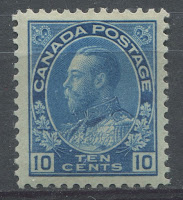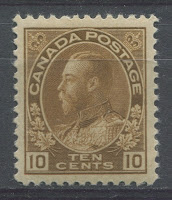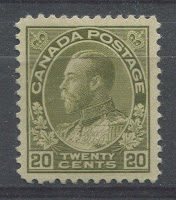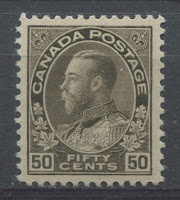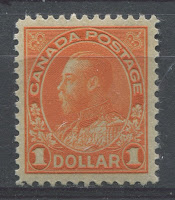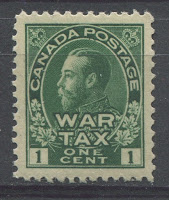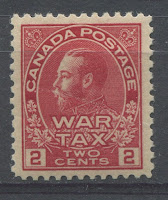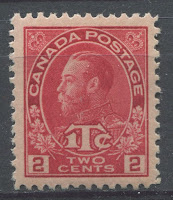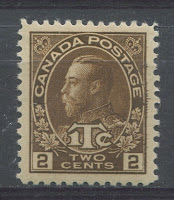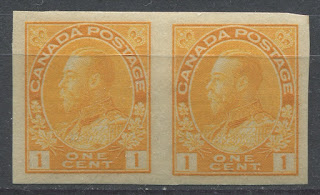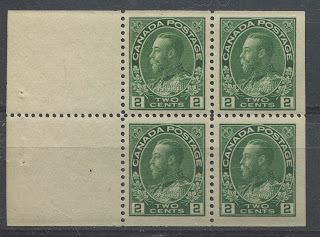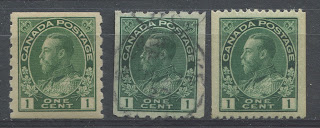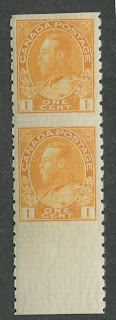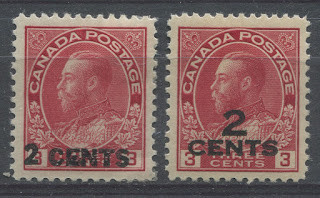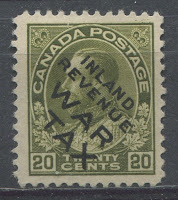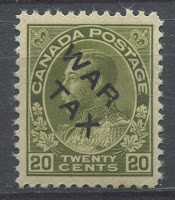The death of King Edward VII on May 6, 1910 necessitated a new series of stamps to be issued bearing a likeness of his son, George V. The design for this new issue, came to be known as the Admiral design because it shows King George V dressed in an Admiral's navy uniform. The actual design was a composite in which the head taken from a photograph by W. & D. Downey and the chest and uniform from a photograph by W. Barnett. The design was engraved by Robert Savage and the first stamps of the series were issued on December 22, 1911. The American Bank Note Company of Ottawa was the printer as with the earlier issues. It changed its name to the Canadian Bank Note Company in 1923.
Of all the modern issues before the current reign, it is this one which offers collectors a vastness of scope that cannot be rivaled. It is the first issue to feature regularly issued coil stamps and booklets which are within reach of the collector with modest means. It offers different printing methods, shade and paper varieties as well as the usual range of imperforates, proofs and re-entries to challenge even the most experienced philatelist. It is also the only issue to feature War Tax stamps, as we shall see.
The issue appeared in three general stages:
- December 22, 1911-February 1913: the first colours of the 1c, 2c, 5c, 7c, 10c, 20c, 50c, first coils and booklets of the 1c, and 2c.
- April 1915-August 1918: the War Tax stamps and the 3c brown in all its formats.
- April 5, 1922-October 16, 1926: the second and third colours of the 1c, 2c, 3c, 5c, 7c and 10c; the 4c, 8c and $1, as well as the remaining coils, booklets and the surcharged stamps.
You could truly spend a lifetime and a veritable fortune on collecting this issue and you still would probably never be able to finish it all. Or, if that is not your preference, you can focus on obtaining one of each value and colour to adorn a single album page.
The Stamps, Issue Dates and Quantities
1c green - December 22, 1911
3,218,000,000 issued.
1c yellow orange - June 7, 1922
1,278,000,000 issued.
2c carmine - December 22, 1911
3,043,000,000 issued.
2c green - April 5, 1922
2,229,000,000 issued.
3c brown - August 6, 1918
2,044,000,000 issued.
3c carmine - December 18, 1923
1,092,000,000 issued.
4c olive bistre - July 7, 1922
75,900,000 issued.
5c dark blue - January 17, 1912
198,000,000 issued.
5c deep purple - February 2, 1922
185,650,000 issued.
7c yellow ochre - January 7, 1912
103,200,000 issued.
7c red-brown - December 12, 1924
16,280,000 issued.
8c blue - September 1, 1925
25,350,000 issued.
10c plum - January 12, 1912
148,800,000 issued.
10c blue - February 20, 1922
128,382,000 issued.
10c bistre brown - August 1, 1925
89,713,000 issued.
20c olive green - January 23, 1912
95,416,000 issued.
50c black brown - January 16, 1912
11,070,000 issued.
$1 orange - July 22, 1923
2,600,000 issued.
1c green War Tax - April 15, 1915
quantity unknown.
2c carmine War Tax - April 15, 1915
quantity unknown.
2c rosine War Tax - January 1, 1916
quantity unknown.
2c dark brown War Tax - August 29, 1916
quantity unknown.
With issue quantities like these, it is fairly easy to see just how scarce many of the issues prior to this one really are, when we consider that even with these very large issue quantities, all mint Admiral stamps in very fine or better condition are scarce. Even in fine condition, some varieties can be challenging. The overall quality of this issue is indeed better than say the King Edward VII issue and the Small Queens, with most stamps that one encounters being at least fine. However, there are still a number of stamps, especially the used high values that are often found in VG condition, either on account of the centering, or the cancellations.
It is unfortunate, but the increasing demand from collectors for never hinged stamps has meant that many collectors are overlooking the very fine hinged stamps from this issue, which is how most of the very fine stamps are found, since it is these stamps that yesterday's collectors chose to display in their albums. Consequently many position multiples and larger blocks have been destroyed at an alarming rate in order to supply the demand for never hinged examples.
Points of Interest
There are several points of interest for this issue which include:
- Wet and dry printing varieties
- Shade varieties
- Paper and gum varieties
- Die types
- Retouched and re-drawn framelines in the upper right spandrel
- Re-entries
- Plate blocks, position pieces and pyramid guide lines
- Imperforate pairs
- Proof material
- Precancels
- Postal history
- Booklet panes and complete booklets
- Experimental coil stamps
- Issued coil stamps
- The philatelic imperforates and part perforate coils
- The 1926 surcharges
- The war tax overprints on the 5c, 20c and 50c
- Lathework
I will now touch briefly on each of these aspects. Separate future posts will cover each in detail.
Wet and Dry Printings
The method used to print these stamps until December 22, 1922 was the wet method, in which the paper was moist during the printing process and the gum was applied later, after the paper had dried. Thus the first colours of the 1c, 2c, 3c, 5c, 7c, and 10c exist only as wet printings. This is true of the sheet stamps, the booklet stamps and the coils.
However, on December 22, 1922 a dry method was introduced whereby the stamps would be printed using dry pre-gummed paper. As many of the second colours of the 1c, 2c, 5c, 7c, and 10c had been issued just prior to the introduction of this method, it is possible to find them in both wet and dry versions. Similarly, the 4c and $1, which were new values were issued prior to the introduction of this method and exist in both types. Finally the 20c and 50c exist in both types because the basic colour of these stamps was not changed during the life of the issue. In addition to the sheet stamps exhibiting such variation, we also see these varieties on the coil stamps and booklet stamps.
The existence of these varieties means that a truly complete set consists of almost twice as many stamps as just the basic number of values and colours.
Shade Varieties
Where this set really shines is in the number of different shade varieties that can be collected for practically every stamp in the set. Unitrade does list several shades, but doesn't even come close to listing them all. What they really do is list broad groups, each of which contain several sub shades. Because of this, collectors often try to slot their stamps into one of the listed groups not realizing that all of their stamps may belong to the same group. Another frustrating aspect of Unitrade's listings is their inconsistency. For example, the 2c and 3c stamps are both listed as "carmine", even though they are completely different shades of red. Also the coils are given different colour names from the main sheet stamps, while none of the names are referenced to an external colour key that all collectors have access to like the Stanley Gibbons colour key. What this effectively means is that you have to have experience working with these stamps to know which colours are which. This can be very frustrating for the beginner who is new to the series and has just a few stamps that they are trying to identify. My post on shades will attempt to explain the shade names and cross reference them to Gibbons Colour Key names and explain the tricks for identifying some of the scarcer ones.
Paper and Gum Varieties
This is an aspect of the issue that is not well covered by Unitrade. In fact the catalogue downright ignores several of the differences in paper and gum that are really quite apparent. However, they do list thin paper varieties on the 1c green, 2c green, 5c violet and 7c red brown, as well as a thick and greyish paper on the 1c green. Finally, a horizontal wove paper variety is listed on the 10c blue. As will be discussed in much more detail in a later post, there are variations in the fineness of the mesh on all values, and in the thickness of the paper that go well beyond what Unitrade lists.
In addition to paper, the gum also varies on this issue, with the early printings having a transparent yellowish gum that is relatively shiny. By the 1915 or so the gum becomes a shiny yellowish cream that has a "sponged" on or "rolled on" appearance. This lasts all the way through to the end of the wet printing period. Then in the early dry printings, then gum is a clear or slightly yellowish shiny gum. Then the gum becomes less shiny, having more of a satin sheen before becoming both shiny and somewhat streaky on the last printings.
Die Types
Both the 1c orange yellow and the 3c carmine from the sheet stamps, as well as the 1916 War Tax stamps were each produced using two different dies. These die variations can be found on the corresponding coil stamps and some of them are very scarce to rare. They generally require a magnifying glass to distinguish, but some, like the types on the War Tax stamps can usually be seen with the naked eye.
Retouched and Re-Drawn Framelines
The upper corners of the design outside the oval are called the spandrels. These spandrels are usually filled with coloured horizontal shading lines that end in a white vertical line just before the outer frame-line. Usually these lines just end abruptly. But on some stamps, they can be found with an extra vertical coloured line joining the horizontal lines. These varieties can be found on the both 5c values, the 7c yellow ochre, the 10c plum, the 20c olive green and the 50c brown black. On some listings, Unitrade calls them the "retouched frameline", while on others, they are called the "re-drawn frameline". The difference seems to lie in the strength of the line, with the re-drawn line being much stronger than the retouched one.
Re-Entries
There are a large number of re-entries that can be collected on these stamps, though it would appear that most are limited to the stamps printed using the wet method before 1925, when nickel-chromium plates were introduced, which did not wear in the same way as the softer steel plates did. The most famous of these on the 1c green is a very rare stamp and worth several thousand dollars. Most are not that rare and worth between $20-$100.
Plate Blocks, Position Pieces and Pyramid Guide Lines
Over 200 different plates were used to print each of the 1c and 2c values, while fewer were used for the other values. This makes for a very daunting challenge in trying to collect all the different plate blocks. Generally, the inscriptions occupy top four stamps in the sheet and so customarily the plate blocks of this issue consist of eight stamps plus the inscription.
This is the first issue in which several of the pane layouts required guillotining rather than perforating. The result is that there are many stamps that exist with straight edges on 1 or two sides. There were in fact four different layouts used to produce the post office sheets:
- 200 subjects divided by a vertical gutter into two panes of 100 stamps each.
- 400 subjects divided by vertical and horizontal gutters into four panes of 100 stamps each.
- 200 subjects arranged in 10 rows of 20 with a guide arrow between the 10th and 11th rows.
- 400 subjects arranged in 20 rows of 20 with guide arrows between 10th and 11th rows and 10th and 11th columns.
Stamps from the first two layouts will always be perforated on all sides. Stamps from the third layout can have straight edges at the top or bottom, while those from the fourth layout can have them on any side or two adjacent sides.
The second colours of the 2c, 3c, 5c, and 10c, as well as the 4c and $1 all exist in blocks that show several guidelines in the margin, arranged in a pyramid shape. These are highly sought after and worth upwards of $1,000 each.
There also exists an "R-Gauge" inscription that is found on the sides of some sheets, reading vertically downwards just below the guide arrows. These are also desirable and worth quite a bit of money - $200-$3,000. It is found on the following stamps:
- 2c green
- 3c carmine
- 5c violet
- 10c blue
- $1 orange
Imperforate pairs
A number of the stamps of this series exist imperforate, although only three stamps including the one above were regularly issued to the public. The regularly issued stamps included the 1c yellow orange, 2c green and 3c carmine, and were issued between January 23, 1924 for the 3c and October 6, 1924 for the other values. The 1c and 2c are always wet printings, whereas the 3c only exists as a dry printing. These three imperforates were issued in relatively low quantities: 50,000 each of the 1c and 2c, and 100,000 of the 3c. Despite these low quantities, a large number appear to have survived, because while they are somewhat scarce, they are not, by any means rare and are worth less than many of the higher value Admirals that were initially issued in far greater numbers.
The imperforates that were not regularly issued, that exist in a quantity of no more than 100 stamps each include:
- 4c olive bistre
- 5c violet
- 7c red brown
- 8c blue
- 10c bistre brown
- 20c olive green
- 50c brown black
- $1 orange
As far as I know they are all dry printings. They are all worth between $2,000 and $4,000 each in a pair, which is normally the only way they are collected. Unlike the 1908 Quebec Tercentenaries, these imperforate stamps were all issued with gum.
Proof Material
Like the other issues I have written about, there exists a healthy range of die proofs, essays and trial colour proofs of this issue. Surprisingly, there are fewer variations than one would expect given the number of stamps and colour changes. However, there is more than enough material here to challenge a dedicated specialist for an entire lifetime. On interesting aspect to the proofs is that there was a proposed 6c value that was never issued.
Precancels
All of the sheet stamps exist precancelled. it is on this issue that precancels really come into their own with as many as 71 styles on the 1c green and most values having 30-40 different styles. It is on this issue that we begin to see more town names, and the familiar three sets of parallel lines. This is an extremely complicated aspect of this issue that could be made as simple or as complicated as you wish.
Postal History
The postal history of this issue is complicated by several rate changes that took place during its life, including the imposition of the War Tax on domestic mail in 2015 and its abolition in 1926. In addition to the rate changes, the use of postal stationery mushroomed during the period. Prior to this issue postal stationery consisted of a few basic envelopes, post bands, wrappers and a few post cards. However, starting with this issue, we begin to see surcharges, precancelled stationery, return notices on envelopes, die types and paper varieties on the post bands & wrappers, and a very large range of different post cards, including mimeograph stock. This one can collect rate covers to different destinations franked with just different combinations of stamps, postal stationery that was used for its intended purpose, or uprated postal stationery.
Booklet Panes and Complete Booklets
All of the low values, being the 1c, 2c and 3c were issued in booklet panes of either 6 stamps or 4 stamps plus two labels as shown below.
The panes were housed in cardboard booklets that bore the Canadian coat of arms as the earlier Edward VII issue had. These booklets sold for 25c each. Starting with this issue, the booklets were issued in both English and French versions. The French versions are priced higher than the English in Unitrade, but not nearly as much as one would expect, given that the issue quantities for French versions were minuscule compared to English. For example, 9,139,000 2c carmine booklet stamps were issued in English booklets compared to just 168,000 stamps in the French booklets. Given that each booklet contained 12 stamps, that is 761,583 English booklets versus just 14,000 French booklets. In addition to the two versions, there were also different fonts and slogans associated with several of the booklets, as well as surcharged rate pages. Together, this results in a very large number of collectible varieties. Because these are listed at the back of the catalogue, collectors often overlook the complete booklets.
Experimental and Issued Coil Stamps
This was the first issue to feature coil stamps that were issued to the public. As I explained in my posts about the 1903-1911 King Edward VII issue, the experimentation that led to the issuance of these stamps began with that issue in 1910, but did not result in an issued product. Experimentation with different methods of joining the coil strips continued with this issue in May 1915, and several rare varieties can be found on the 2c carmine. However, the first coil stamps of this issue were actually issued in October 1912.
The picture above shows the three basic formats in which coil stamps were issued for these stamps. The coils were issued for all the low values, being the 1c, 2c and 3c values, as well as both the rosine and brown War Tax stamps.
The first format to appear and the one that endured throughout the life of the issue was the one on the left, in which the stamps were perforated 8 vertically and delivered horizontally by the stamp dispensing machines. The perforation is very coarse and consequently used examples with intact perforations are hard to come by. The War Tax coils were only issued in this format. This format was used for both colours of the 1c, 2c and 3c.
The second format was introduced in February 1913, and from what I can see from the cancellation dates I have come across, it was relatively short lived, being completely gone by 1920. The only stamps to be issued in this format are the 1c green and 2c carmine, and they are only found in the early shades.
The third format on the right was experimental and in use from about 1915 to 1924. It was thought that finer perforations would be suitable for dispensation by vertical delivery. All the stamps that were issued this way are wet printings, and it was employed for the 1c green, 2c carmine, 2c green and 3c brown. Judging by the fact that it does not appear again on subsequent issues, it was not a success.
The Part Perforate Coil Stamps
The post office decided in 1924 to issue sheets of left over coil stock that had not yet been guillotined to the public. 50,000 of each of the 1c yellow orange and 2c green dry printing were issued in sheet form. These have been cut a part by philatelists using scissors and are usually collected as vertical pairs or blocks of 4. Like the imperforates, a very large number of these were saved by collectors, with the result that they are not values nearly as highly as one would expect, being $20-$60 a pair depending on condition.
In additon to these dry printings, both values and the 3c carmine were also issued in a quantity of 2,200 by favour only, in the wet printing format. This is the only way, other than the regularly issued coil that the 3c carmine exists as a wet printing. These are very rare and worth $200-$1,500 a pair depending on condition.
The image below shows the dry printing of the 1c orange yellow in a vertical pair.
The 1926 Surcharges
The War Tax on domestic mail was abolished in 1926, lowering the domestic letter rate from 3c to 2c, and consequently creating a swell of demand for the 2c stamp. When stocks of the 2c ran low in 1926, the post office decided that rather than waste the existing stocks of the 3c stamp, they would surcharge them down to 2c. Two different surcharge settings were employed as shown below:
The surcharge on the left was issued October 12, 1926 and was issued in a quantity of only 50,000. The vast majority of the overprinted stamps are die 1. A very small percentage were the die 2 variety which had just appeared two years earlier. The setting on the right is the more common of the two, being issued in a quantity of 103,600. Once again, despite relatively low issue quantities, while these stamps are scarce and desirable, they are not valued as highly as one would expect. There are several varieties of overprint that can be collected including double, triple and shifted surcharges.
The 5c, 20c and 50c War Tax Overprints
Quantities of the 5c, 20c and 50c were overprinted as shown above. The overprint on the 50c is red because of the fact that the basic colour of the 50c at this time was black. They were intended for revenue, rather than postal use, so that postally used stamps are very rare. For some reason it appears that the sheets supplied for these overprints were the poorly centered ones, with the result that these stamps are very hard to find well centered. They are all worth upwards of $50 up to a few thousand dollars for superbly centered NH examples.
Lathework
In 1916 the American Bank Note Company began the practice of engraving a solid band of an engine turned pattern at the bottom of the sheets. This was intended to help them gauge the state of wear on the plates, as the pattern would become weaker and weaker as the plate wore. Specialists have identified up to seven different patterns. These are referred to as lathework, and pieces like the one above are highly sought after by specialists. Some stamps, such as the 3c brown can be found with as many as 10 different types of lathework. Some of these are extremely valuable and most are several hundred dollars a single. In addition, some new discoveries in terms of types have been made in the past few years, so this is an area which shows some promise for specialists.
This concludes my overview of the issue. My next posts will begin delving into each aspect of the issue in more detail. I will start with the difference between wet and dry printings, and the tricks you can use to distinguish them, and then before I get into the shades, I will do a quick crash course in the language of colour and how to use the Stanley Gibbons colour key to name colour shades.


